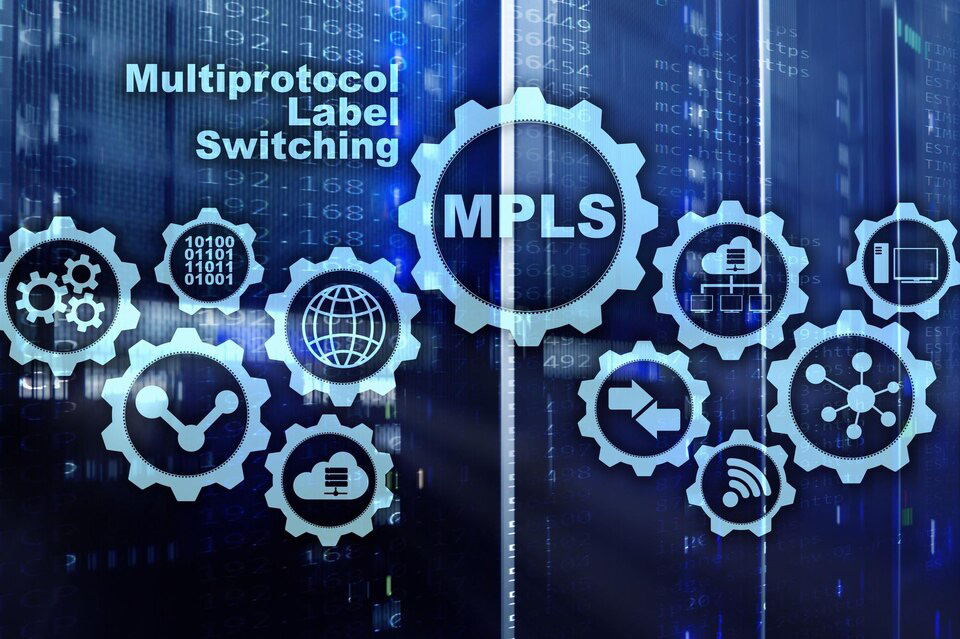July 12, 2023
SD-WAN vs MPLS – Which is Better for Your Business?

In the ever-evolving landscape of enterprise networking, organizations face the challenge of selecting the right technology to meet their evolving connectivity needs. Traditionally, Multiprotocol Label Switching (MPLS) has been the go-to solution for wide area network (WAN) connectivity. However, with the emergence of Software-Defined Wide Area Networking (SD-WAN), businesses now have an alternative that promises enhanced performance, flexibility, and cost savings. In this article, we will delve into the comparison between SD-WAN and MPLS, exploring their strengths, weaknesses, and the factors to consider when choosing the best option for your business.
What is MPLS?

Multiprotocol Label Switching (MPLS) is a protocol-based technology used in computer networks to efficiently route data packets between different nodes or network devices. It operates at the layer 2 (data link layer) and layer 3 (network layer) of the OSI (Open Systems Interconnection) model and is widely used in wide area networks (WANs) and service provider networks.
To view more information: What is an MPLS network and how does it work?
At its core, MPLS works by adding a label to each data packet, which helps determine its forwarding path. These labels are inserted by MPLS-enabled routers or switches at the ingress point of the network and are used to guide the packets through the network to their destination. The labels are based on a predefined set of rules or protocols, and they allow for faster and more efficient routing decisions compared to traditional IP-based routing.
Pros of MPLS
Multiprotocol Label Switching (MPLS) offers several advantages that make it a preferred choice for organizations in building their network infrastructure. Here are some of the key pros of MPLS:
- Efficient and Fast Data Routing: MPLS enables efficient and fast data routing by using labels to determine the forwarding path of packets. These labels are added at the ingress point and allow routers to make forwarding decisions based on the labels rather than examining the packet headers at every hop. As a result, MPLS can deliver faster data transmission and reduced latency, making it suitable for real-time applications like voice and video.
- Quality of Service (QoS): MPLS supports traffic engineering and QoS capabilities, allowing organizations to prioritize critical applications and allocate resources accordingly. With MPLS, different classes of service can be defined, and bandwidth can be allocated based on specific requirements. This ensures that high-priority traffic receives the necessary resources, leading to improved performance, reduced packet loss, and better end-user experience.
- Scalability: MPLS is highly scalable and can accommodate a large number of network nodes and virtual private networks (VPNs). It provides the flexibility to handle growing network demands and supports thousands of VPNs within a single infrastructure. This scalability makes MPLS suitable for organizations with expanding networks or those that need to connect multiple branches or remote locations.
- Traffic Engineering: MPLS offers advanced traffic engineering capabilities, allowing network administrators to optimize the flow of traffic across the network. By defining explicit paths for specific types of traffic, MPLS enables better control over the network’s behavior. Traffic engineering helps in load balancing, improving network utilization, and avoiding congestion by efficiently distributing traffic across available resources.
- Enhanced Security: MPLS enhances network security by creating virtual private networks (VPNs) and establishing secure tunnels for traffic. It provides traffic isolation, ensuring that data from different VPNs remains separate and cannot be accessed by unauthorized entities. MPLS can also integrate encryption technologies to secure data transmission, protecting sensitive information from potential threats.
- Simplified Network Management: MPLS simplifies network management by centralizing control and configuration. With MPLS, network administrators can define and manage policies from a central location, making it easier to implement changes or updates across the network. The centralized control allows for better visibility, monitoring, and troubleshooting of network performance and helps in quickly identifying and resolving issues.
- Support for Multiple Services: MPLS supports multiple services and applications, including voice, video, and data, over a single network infrastructure. This eliminates the need for separate networks for different types of traffic, reducing complexity and infrastructure costs. MPLS can handle diverse traffic types efficiently, ensuring the quality and reliability of services across the network.
- Seamless Integration with Existing Networks: MPLS can seamlessly integrate with existing network infrastructures, making it a suitable choice for organizations looking to upgrade or expand their networks. It can coexist with other networking technologies, such as IP-based routing, allowing for a gradual migration or hybrid network deployments.
- Provider-Managed Service: MPLS is often offered as a managed service by service providers, relieving organizations of the burden of network management and maintenance. Service providers can take care of the implementation, monitoring, and troubleshooting of the MPLS network, allowing organizations to focus on their core business activities.
- Support for Converged Networks: MPLS enables the convergence of different types of traffic onto a single network infrastructure. Voice, video, and data can all be transmitted over the MPLS network, simplifying network architecture and reducing the need for separate networks for each traffic type. This convergence leads to cost savings, improved efficiency, and better resource utilization.
- Cons of MPLS
While Multiprotocol Label Switching (MPLS) offers numerous benefits, there are also some potential drawbacks and considerations that organizations should be aware of:
- Cost: MPLS services can be more expensive compared to other networking options. The implementation and maintenance costs associated with MPLS, including dedicated hardware, licenses, and service provider charges, can be higher. Organizations need to carefully evaluate their budget and cost-effectiveness before opting for MPLS.
- Long Deployment Times: MPLS implementations can often take longer compared to other networking technologies. The provisioning and setup of MPLS circuits typically require coordination with service providers, physical installation of equipment, and configuration, which can result in longer lead times for network deployment or expansion.
- Bandwidth Limitations: Traditional MPLS circuits have predefined bandwidth limits, which can be a disadvantage for organizations with fluctuating bandwidth requirements. Scaling up or down the bandwidth on MPLS circuits can involve additional costs or coordination with service providers, making it less flexible in handling sudden spikes or drops in network traffic.
- Dependency on Service Providers: MPLS networks typically rely on service providers for implementation, management, and troubleshooting. Organizations may have limited control over network changes or optimizations, as they need to rely on the service provider’s capabilities and responsiveness. This lack of control can impact the ability to quickly address network issues or make immediate changes.
- Compatibility with Legacy Systems: MPLS networks may face compatibility issues with older or legacy systems. Upgrading or integrating MPLS with existing network infrastructure may require additional configuration or hardware updates, potentially causing disruptions or compatibility challenges.
- Limited Geographic Coverage: MPLS services may have limitations in terms of geographic coverage, especially in remote or less developed areas. Organizations with a wide geographic footprint or branch offices in such locations may face challenges in accessing MPLS services or may incur higher costs for extended coverage.
What is SD-WAN?

SD-WAN, which stands for Software-Defined Wide Area Networking, is a modern networking technology that enables organizations to securely connect and manage their wide area networks (WANs). It utilizes software-defined networking (SDN) principles to centralize control and management of network traffic, offering enhanced performance, flexibility, and cost savings compared to traditional WAN architectures.
SD-WAN leverages multiple network connections, including broadband internet, MPLS, 4G/5G, and satellite links, to create a hybrid network infrastructure. It intelligently routes network traffic based on real-time conditions, application requirements, and business policies. This dynamic and intelligent routing ensures optimal performance and efficient utilization of available network resources.
Pros of SD-WAN
- Enhanced Network Performance: SD-WAN optimizes network performance by intelligently routing traffic across multiple network paths. It dynamically selects the most efficient and reliable path for each application or data flow, based on real-time conditions such as latency, packet loss, and available bandwidth. This ensures that critical applications receive the necessary resources and that network performance is maximized, resulting in improved user experience and productivity.
- Cost Savings: SD-WAN allows organizations to reduce costs associated with traditional WAN architectures. By leveraging cost-effective internet connections alongside or as alternatives to expensive dedicated lines like MPLS, organizations can achieve significant cost savings. SD-WAN’s ability to intelligently route traffic over the most cost-effective paths reduces reliance on expensive infrastructure, optimizing network expenses without compromising performance.
- Flexibility and Scalability: SD-WAN offers greater flexibility and scalability compared to traditional WAN solutions. It enables organizations to easily add new network locations, connect remote offices, and integrate cloud-based resources. SD-WAN’s centralized management and software-based configuration allow for rapid deployment and simplified network changes, eliminating the need for physical reconfiguration of network devices. This scalability empowers organizations to adapt to evolving business needs and seamlessly expand their network infrastructure.
- Enhanced Security: SD-WAN provides advanced security features to protect network traffic and data. It offers end-to-end encryption, secure connectivity, and integrated firewall capabilities. SD-WAN’s centralized management allows for consistent security policy enforcement across the network, ensuring a unified and robust security posture. With SD-WAN, organizations can maintain the confidentiality and integrity of their data while adhering to compliance requirements.
- Simplified Network Management: SD-WAN simplifies network management through its centralized control and management capabilities. Administrators can monitor and manage the entire network from a single management console, streamlining operations and reducing complexity. SD-WAN’s intuitive interface allows for easy configuration of network policies, application prioritization, and traffic management. This simplified management approach saves time and effort, enabling IT teams to focus on strategic initiatives rather than routine network maintenance tasks.
Also Read: Why do you need an SD WAN for your Business?
Cons of SD-WAN
While SD-WAN offers numerous benefits, it’s important to consider potential disadvantages and challenges. Here are five cons of SD-WAN:
- Initial Deployment Complexity: Implementing SD-WAN can be initially complex, especially for organizations with existing network infrastructures. It needs careful planning & coordination to ensure smooth transition. Migrating from traditional WAN architectures to SD-WAN may involve reconfiguration of network devices, integration with existing security systems, and training IT staff on new management tools. Adequate planning and expertise are essential to minimize disruptions during the deployment process.
- Dependence on Internet Connectivity: SD-WAN relies heavily on Internet connections, including broadband and other public networks. While these connections are often cost-effective and readily available, they may not offer the same level of reliability and performance as dedicated private connections like MPLS. Organizations operating in areas with limited internet infrastructure or unreliable connectivity may experience challenges in maintaining consistent network performance.
- Security Concerns: While SD-WAN incorporates security features, there are potential security concerns to consider. The use of public networks for connectivity exposes data to potential threats and attacks. Organizations must ensure that appropriate security measures are in place, including encryption, firewalls, and intrusion detection and prevention systems. In some cases, additional security measures or integration with existing security infrastructure may be necessary to maintain robust protection.
- Learning Curve for IT Staff: SD-WAN introduces new technologies and management tools, which require IT staff to acquire new skills and knowledge. The learning curve associated with understanding SD-WAN concepts, configuring policies, and troubleshooting issues can be steep. Organizations must invest in training and skill development to ensure that IT teams are well-equipped to manage and maintain the SD-WAN environment effectively.
- Potential Complexity in Hybrid Deployments: Some organizations choose to adopt a hybrid networking approach, combining SD-WAN with existing legacy infrastructure or cloud-based services. While this approach offers flexibility, it can introduce complexity in terms of integration, management, and security. Managing multiple networking technologies and ensuring seamless connectivity between different environments may require additional expertise and effort.
SD-WAN vs MPLS: Which is Better for My Business?
In today’s digital landscape, where businesses are increasingly reliant on robust and efficient network connectivity, the choice between SD-WAN and MPLS has become a critical decision. Both technologies offer unique advantages and considerations, and understanding their differences can help organizations determine which solution is better suited for their specific business needs.
MPLS (Multiprotocol Label Switching) has long been a reliable and widely adopted networking technology. It provides a secure and predictable method for transmitting data across wide area networks (WANs). MPLS networks offer guaranteed quality of service (QoS), low latency, and strong reliability, making them well-suited for businesses with stringent requirements for real-time applications, such as voice and video communication.
On the other hand, SD-WAN (Software-Defined Wide Area Networking) has emerged as a more flexible and cost-effective alternative to traditional WAN architectures. SD-WAN leverages software-defined networking (SDN) principles to dynamically route network traffic over multiple paths, including broadband internet, MPLS, and cellular networks. It offers centralized management, improved application performance, cost savings, and increased agility.




